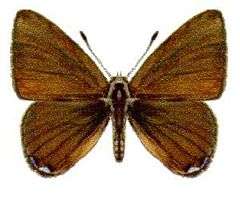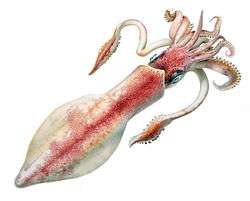Parazoa
| Parazoa Temporal range: Ediacaran - Recent | |
|---|---|
| A sponge | |
| Scientific classification | |
| Kingdom: | Animalia |
| Subkingdom: | Parazoa Grant & Todd, 1838 |
| Phyla | |
| |
The Parazoa, are a proposed clade of animals. Traditionally, Parazoa, literally translated as "beside the animals", only consisted of Porifera and the Placozoa. It still is a basal animal group, but has been refuted in the original sense (i.e. as sister of the Eumetazoa). It now appears the Planulozoa/Eumetazoa actually are sister of the Placozoa, together forming the ParaHoxozoa/Epitheliozoa clade.[1][2][3][4][5][6][7][8] With a cladistical inclusion of the Eumetazoa, Parazoa consists of the Porifera and the ParaHoxozoa/Epitheliozoa clade.[9] The Ctenophora, originally part of Eumetazoa, appear to be the basalmost animals. So the original meaning of "beside the animals" now only works either in the sense of being paraphyletic stem group or if one considers the Ctenophora to be THE animals, neither of which is very satisfactory. An alternative name for this grouping has not been proposed. Given that the Porifera already have a ParaHox gene, ParaHoxozoa could be expanded to include Porifera, making it equivalent to Parazoa. Some authors only consider the Porifera when discussing the Parazoa.
Ctenophora as sister of all animals, as discussed here, has been considered controversial ever since the proposal in 2008. An alternative proposal is the Porifera-sister hypothesis.
Synapomorphies/Homologues
New genes in the Parazoa are:[10][11][12]
- The NK gene and Cdx Parahox are present.[13]
- The small RNA processing enzymes TRBP2, Drosha, Pasha. Also the microRNA functionality emerged.
- The immune genes (specifically RDH,MyD88, Toll-like R, Nod-like R)
- The Nitric Oxide Neurotransmitter.
- Parazoa have nearly every type of cell adhesion gene.
Of the development pathways:
- JAK/STAT, and more advanced TGF-b, Wnt, Notch emerged.
- Questionable: Hedgehog/BMP
- RTK may be present ancestrally.
- NR's are not present in porifera.
The above may depend on the specific sampled species, e.g. Pleurobrachia vs Amphimedon. Careful: some genes may have been present already earlier, possibly in modified form, or may have developed significantly later.
Cladistics
Most animals now appear to have emerged in the parazoa,[1] but the ctenophora appear to be basalmost animals. In some literature Parazoa is taken as equivalent to Porifera. Mesozoa appears to be sister to Rouphozoa in Platytrochozoa. It is indicated approximately how many million years ago (Mya) the clades diverged into newer clades.[14][15]
| Apoikozoa (950) |
| ||||||||||||||||||||||||||||||||||||||||||||||||
References
- 1 2 Holt, Jack R.; Iudica, Carlos A. (2016-08-28). "The Parazoa". Systematic Biology. Retrieved 2017-10-11.
- ↑ Hill, April; Boll, Werner; Ries, Carolin; Warner, Lisa; Osswalt, Marisa; Hill, Malcolm; Noll, Markus (2010). "Origin of Pax and Six gene families in sponges: Single PaxB and Six1/2 orthologs in Chalinula loosanoffi". Developmental Biology. 343 (1–2): 106–123. doi:10.1016/j.ydbio.2010.03.010.
- ↑ Dunn, Casey W.; Hejnol, Andreas; Matus, David Q.; Pang, Kevin; Browne, William E.; Smith, Stephen A.; Seaver, Elaine; Rouse, Greg W.; Obst, Matthias (2008). "Broad phylogenomic sampling improves resolution of the animal tree of life". Nature. 452 (7188): 745–749. doi:10.1038/nature06614.
- ↑ Whelan, Nathan V.; Kocot, Kevin M.; Moroz, Tatiana P.; Mukherjee, Krishanu; Williams, Peter; Paulay, Gustav; Moroz, Leonid L.; Halanych, Kenneth M. (2017-10-09). "Ctenophore relationships and their placement as the sister group to all other animals". Nature Ecology & Evolution. 1: 1737–1746. doi:10.1038/s41559-017-0331-3. ISSN 2397-334X.
- ↑ Shen, Xing-Xing; Hittinger, Chris Todd; Rokas, Antonis (2017-04-10). "Contentious relationships in phylogenomic studies can be driven by a handful of genes". Nature Ecology & Evolution. 1 (5): 0126. doi:10.1038/s41559-017-0126. ISSN 2397-334X.
- ↑ Ryan, Joseph F.; Pang, Kevin; Schnitzler, Christine E.; Nguyen, Anh-Dao; Moreland, R. Travis; Simmons, David K.; Koch, Bernard J.; Francis, Warren R.; Havlak, Paul (13 December 2013). "The Genome of the Ctenophore Mnemiopsis leidyi and Its Implications for Cell Type Evolution". Science. 342 (6164): 1242592. doi:10.1126/science.1242592. ISSN 0036-8075. PMC 3920664. PMID 24337300.
- ↑ Babonis, Leslie S.; Martindale, Mark Q. (2017-02-05). "Phylogenetic evidence for the modular evolution of metazoan signalling pathways". Phil. Trans. R. Soc. B. 372 (1713): 20150477. doi:10.1098/rstb.2015.0477. ISSN 0962-8436. PMC 5182411. PMID 27994120.
- ↑ Arcila, Dahiana; Ortí, Guillermo; Vari, Richard; Armbruster, Jonathan W.; Stiassny, Melanie L. J.; Ko, Kyung D.; Sabaj, Mark H.; Lundberg, John; Revell, Liam J. (2017-01-13). "Genome-wide interrogation advances resolution of recalcitrant groups in the tree of life". Nature Ecology & Evolution. 1 (2): 0020. doi:10.1038/s41559-016-0020. ISSN 2397-334X.
- ↑ Miller, David J.; Hayward, David C.; Reece-Hoyes, John S.; Scholten, Ingo; Catmull, Julian; Gehring, Walter J.; Callaerts, Patrick; Larsen, Jill E.; Ball, Eldon E. (2000-04-25). "Pax gene diversity in the basal cnidarian Acropora millepora (Cnidaria, Anthozoa): Implications for the evolution of the Pax gene family". Proceedings of the National Academy of Sciences. 97 (9): 4475–4480. doi:10.1073/pnas.97.9.4475. ISSN 0027-8424. PMC 18259. PMID 10781047.
- ↑ Moroz, Leonid L.; Kocot, Kevin M.; Citarella, Mathew R.; Dosung, Sohn; Norekian, Tigran P.; Povolotskaya, Inna S.; Grigorenko, Anastasia P.; Dailey, Christopher; Berezikov, Eugene (2014-06-05). "The ctenophore genome and the evolutionary origins of neural systems". Nature. 510 (7503): 109–114. doi:10.1038/nature13400. ISSN 0028-0836. PMC 4337882. PMID 24847885.
- ↑ Wolpert, Lewis; Tickle, Cheryll; Arias, Alfonso Martinez (2015). Principles of Development. Oxford University Press. ISBN 9780198709886.
- ↑ Evolution and Development - page 38 Archived 2014-03-02 at the Wayback Machine.
- ↑ Fortunato, Sofia A. V.; Adamski, Marcin; Ramos, Olivia Mendivil; Leininger, Sven; Liu, Jing; Ferrier, David E. K.; Adamska, Maja (2014). "Calcisponges have a ParaHox gene and dynamic expression of dispersed NK homeobox genes". Nature. 514 (7524): 620–623. doi:10.1038/nature13881.
- ↑ Peterson, Kevin J.; Cotton, James A.; Gehling, James G.; Pisani, Davide (27 April 2008). "The Ediacaran emergence of bilaterians: congruence between the genetic and the geological fossil records". Philosophical Transactions of the Royal Society of London B: Biological Sciences. 363 (1496): 1435–1443. doi:10.1098/rstb.2007.2233. ISSN 0962-8436. PMC 2614224. PMID 18192191.
- ↑ Parfrey, Laura Wegener; Lahr, Daniel J. G.; Knoll, Andrew H.; Katz, Laura A. (16 August 2011). "Estimating the timing of early eukaryotic diversification with multigene molecular clocks". Proceedings of the National Academy of Sciences. 108 (33): 13624–13629. doi:10.1073/pnas.1110633108. ISSN 0027-8424. PMC 3158185. PMID 21810989.
External links
| Wikispecies has information related to Parazoa |
| Wikimedia Commons has media related to Parazoa. |



